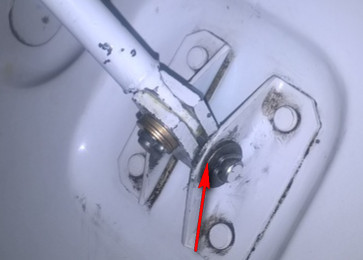Yes; it is somewhat weird but with regular greasing (every Annual, if operated on tarmac) should last “for ever”. My gear is still OK at 15 years but I had to change the entire linkage (x2) because in the early years of my ownership I was using company maintenance and none of them ever lubed it, and I never noticed. In the future, this is a perfect candidate for owner manufactured parts – not possible (officially) under EASA of course.
However, the “bearing” formed by the ~1.5mm aluminium here

is obviously not going to last long, unless that pin doesn’t rotate inside it. There isn’t going to be an easy (official) fix for that bracket which is riveted to the gear door, once it is worn. The official position is to buy a whole new door. Hence a degree of play is acceptable and 10mm (at the base of the gear door) is common. What matters is that the door is just-tight when up, as I wrote above.
Excellent helpful video! Found the “repaired” gear door with similar play like you presented, assuming that it already weared out that bit of play you demonstrated. The other gear door is too tight on ground, and will obviously wear out hinges and pin connection sooner or later as you mentioned. Maybe I have opportunity to check the gear door play on jacks in contrast and post a similar video here – however I agree that stress on hinges and rods is too high during operation (although Tarmac operating only, but: without any greasing…) – I haven´t found the MM pointing directly to the play, but maybe I could get only the light version of the MM from the respective forum (not having the CD). However if you have the relevant page of the MM at your fingertips you´d perhaps PM it; however no urgent matter.
The Feb 2006 MM CD is freely available if you supply your mailing address 
The Socata owners’ groups claims to have the latest version but I have not seen any page there which has been updated later than Feb 2006. Last edits I have seen were in 2005.
I don’t know if or where the door play is specified, either.
Today the topic “post maintenance check” had a whole new meaning for me … While really everything technical seems to be perfect, they polished the underside of the wings before I got the airplane (!) I missed that they changed many avionics (and other) settings and stepped into the trap like an idiot.
The avionics guy even told me that they “had changed all frequencies etc” … but the one thing I did not get was that after they had checked the Radio Nav equipment that the NAV SOURCE on the PFD was set to VLOC instead to “GPS1” where I ALWAYS have it.
So when I took off into harmless (but bumpy) IMC and pressed “NAV” at 500 feet to let the autopilot fly the departure route, the airplane turned away from the course (to some set VOR) and I had the never seen before “NAV INVALID” message on the PFD … The SID was easy enough to be flown manually but it was a good lecture how little things can really distract you. The same moment I got the “NAV INVALID” message I should have changed the frequency, and of course I had to let the TWR repeat it, because I was so distracted flying the turn back to the SID and trying to find the failure … thankfully I saw it quickly, pressed the key next to the PFD, GPS1 appeared and all was good.
Little mistake, but it can quickly make you nervous climbing into bumpy IMC.
Alexis wrote:
that the NAV SOURCE on the PFD was set to VLOC instead to “GPS1” where I ALWAYS have it.
Woooaaahh! How can you possibly pass your annual IR renewal? You must have the most complacent examiner in Europe except for those that are paid to look the other way. And the HSI source is displayed on your PFD.
I had told myself I would shut the f*** up, but I just cannot.
That’s a pretty arrogant remark I would only accept from s.b. who never makes mistakes.
I have checked the complete plane, all avionics settings …everything. The only thing I missed was the NAV source, and that was only because I fly around 150 hrs/year and NEVER touch the NAV source … and only use GPS on #1, except when I fl an ILS, which I only do where RNAV is not available.
There’s no reason to get overly excited, because I caught it within 5 seconds and simply hand flew for a moment.
(PS: I do my IR renewal with official LBA examiners, and I never had a problem renewing it ;-))
(EDITED)
Alexis wrote:
and NEVER touch the NAV source on the PFD … I only switch from GPS to VLOC on the navigator,
But those should be coupled. When you change the source on the PFD from GPS1 to VLOC1 the GPS should change from GPS to VLOC. If they don’t change in both places, something is wrong on your installation. That has worked on the GNS430/Avidyne EX5000 combos I’ve flown
It is all good, I just did not see that the #1 Navigator was set to VLOC instead of GPS.
Of course what I wrote was misleading. It was not relevant.
I just wanted to express that I never use the switch on the PFD, just the CDI switch.